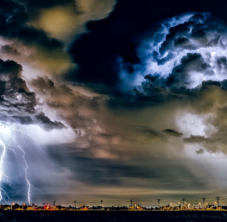Which way does the (economic) wind blow? Can politicians in Montgomery County predict it with any accuracy?
Less than five months after touting the “Promoting Offshore Wind Energy Resources” or “POWER” Act in Annapolis, MoCo-based Maryland politicians like Delegate Lorig Charkoudian (Democrat, District 20) are re-discovering (or perhaps learning) that it is easy to pass “transformative sounding” legislation and spend other people’s time and money… but hard to predict the future, economic or otherwise. It is also really hard to execute on a complex, multi-stage energy “asset” engineering plan that relies on global supply chains being fully functioning, super-low (many would say artificially low) interest rates, and competent, fiscally-sound politicians who know what a budget is in Washington, DC.
None of those three “factors” for the success of “offshore wind energy” off of Maryland are really happening right now, nor will they likely be occurring any time in the near-future.
Just over two weeks ago, amid “supply chain and tax incentive issues”, Danish energy giant Ørsted announced it was re-shuffling its U.S. projects. With regard to an impact on Maryland projects, the headlines blared out:
And now we know that the project (called “Skipjack Wind Farm”) has been suspended because it does not meet “value creation criteria” per Orsted. Reporting by Christine Condon at BaltimoreSun.com reveals:
Here is a quick translation into normal, everyday English of what this statement means: “We (Orsted), see this project as super-capital intensive at a time when we’d like to conserve capital, not burn it in North America, and we do not see this wind energy project as a profitable one for the foreseeable future… despite the state of Maryland’s regulatory hand-holding, promised financial help, and despite the promised millions and millions of federal government debt-dollars.”
The “exploring options” part is also no doubt a way to further get leverage on politicians and extract even more concessions be it state land, utility assets or direct taxpayer subsidies. To the “POWER” Act’s credit, there aren’t any major give aways packed into legislation (as of yet). But the state does want to spend (undoubtedly) millions of tax dollars on a “commission” to “study” how it can create a centralized transmission line infrastructure connecting offshore wind to the bulk of the mid-Atlantic power grid.
Maryland politicians, particularly from Montgomery County, are all about a quick-hitting, positive sounding headlines, so that is why the “POWER” Act even made it through both houses in Annapolis in 2023. Keep in mind, this was the third such “wind power bill” passed over the last decade. The state still gets a minimal amount of energy to its power grid supplied via wind-generated power. It was never about something real or likely to happen, it was all about wishing for an outcome (“8.5 gigawatts” of energy by 2030) and then staking a claim to future federal largesse. But the federal government is a ridiculous $33.7 trillion dollars in debt and will soon spend a trillion just on interest alone. Does it ever occur to local Annapolis legislators that the country, at-large, shouldn’t be on the hook for a costly experiment in one smaller state?
There was another short-term reason for the “POWER” Act as well, in tandem with the positive sounding headlines for a singular news cycle — to get politicians awards from local special interest lobbies and groups. Delegate Charkoudian posted the following on her lorigd20.com campaign website just a few weeks ago, just around the same time as the Orsted news about suspending the project was breaking:
Offshore wind may still pan out, via smaller projects and other focused vendors… but nobody can predict the future, particularly in volatile global energy markets and amidst geopolitical risk rising everywhere on the globe. Wasting taxpayer money on a commission isn’t going to move the needle on “alternative energy” – the focus should be on reliable energy and a grid that doesn’t get overloaded when it matters the most.







